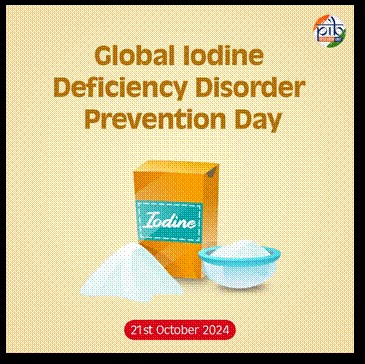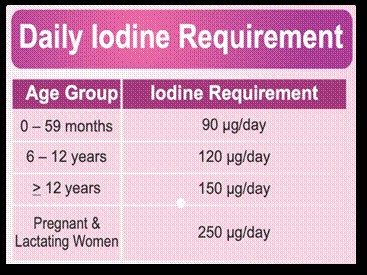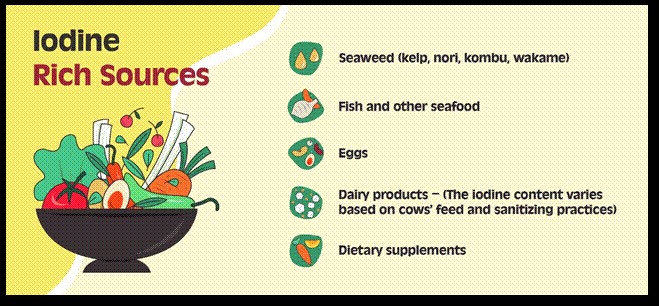Ministry of Health and Family Welfare
World Iodine Deficiency Day
Strengthening Public Health through Awareness and Action
Posted On:
20 OCT 2024 4:15PM by PIB Delhi
Introduction
World Iodine Deficiency Day, also known as Global Iodine Deficiency Disorders Prevention Day, is observed annually on 21st October. The day aims to raise awareness about the essential role of iodine in maintaining good health and to emphasize the consequences of iodine deficiency. This document outlines the importance of iodine in daily nutrition and its crucial significance in preventing iodine deficiency disorders.

What is Iodine?
Iodine is an essential component of the thyroid hormones, thyroxine (T4) and triiodothyronine (T3), which regulate metabolism and are crucial for fetal and infant development. Found in foods and iodized salt, iodine exists in several forms, including sodium and potassium salts, inorganic iodine (I2), iodate, and iodide. Iodide, the most common form, is quickly absorbed in the stomach and used by the thyroid for hormone production. Most excess iodide is excreted through urine.

What happens in Iodine Deficiency?
Iodine deficiency has multiple adverse effects on growth and development and is the most common cause of preventable intellectual disability in the world. Iodine deficiency disorders result from inadequate thyroid hormone production secondary to insufficient iodine. During pregnancy and early infancy, iodine deficiency can cause irreversible effects.
- If a person’s iodine intake falls below approximately 10–20 mcg/day,
hypothyroidism occurs, a condition that is frequently accompanied by goitre.
Goitre is usually the earliest clinical sign of iodine deficiency.
- In pregnant women, iodine deficiency of this magnitude can cause major
neurodevelopmental deficits and growth retardation in the fetus as well as
miscarriage and stillbirth.
- Chronic, severe iodine deficiency in utero causes cretinism, a condition
characterized by intellectual disability, deaf mutism, motor spasticity,
stunted growth, delayed sexual maturation, and other physical and
neurological abnormalities.
- In infants and children, less severe iodine deficiency can also cause
neurodevelopmental deficits such as somewhat lower than average intelligence
as measured by IQ.
- Mild to moderate maternal iodine deficiency has also been associated with an
increased risk of attention deficit hyperactivity disorder in children.
- In adults, mild to moderate iodine deficiency can cause goiter as well as
impaired mental function and work productivity secondary to hypothyroidism.
- Chronic iodine deficiency may be associated with an increased risk of the
follicular form of thyroid cancer.
National Efforts to Eradicate Iodine Deficiency
Recognizing the serious health implications of iodine deficiency, the Government of India initiated national efforts to combat the problem through the National Goitre Control Programme (NGCP) in 1962. This program marked a significant step toward addressing iodine deficiency, which was linked to conditions such as mental and physical retardation, cretinism, and stillbirths.
In 1992, the program was broadened and renamed the National Iodine Deficiency Disorders Control Programme (NIDDCP) to cover a wider range of iodine deficiency disorders (IDD) and ensure its implementation across all States and Union Territories.

Primary goals of NIDDCP include:
- Reducing the prevalence of IDD to below 5% nationwide.
- Achieving 100% consumption of adequately iodized salt (with 15 ppm of iodine) at the household level.
To accomplish these goals, the programme focuses on several key objectives:
- Conducting surveys to assess the magnitude of IDD in different districts.
- Replacing common salt with iodized salt in affected regions.
- Conducting resurveys every five years to measure the impact of iodized salt on IDD.
- Monitoring iodized salt quality and urinary iodine excretion through laboratory testing.
- Promoting health education and public awareness about iodine’s role in preventing IDD.
A major policy decision was made in 1984 to iodize all edible salt in India, which became a phased initiative starting in 1986. By 1992, the country aimed to fully transition to iodized salt. Today, India produces 65 lakh metric tonnes of iodized salt annually, which is sufficient to meet the needs of its population. This ongoing national effort underscores the government’s commitment to eradicating iodine deficiency and improving public health.
Achievements of the National Iodine Deficiency Disorders Control Programme (NIDDCP)
The implementation of the National Iodine Deficiency Disorders Control Programme (NIDDCP) has led to significant achievements in the reduction of iodine deficiency disorders (IDD) across India:
- Reduction in Total Goiter Rate (TGR): The programme has substantially reduced the Total Goiter Rate, a key indicator of iodine deficiency, across the country.
- Increased Iodized Salt Production & Consumption: The production of iodized salt has reached 65 lakh metric tonnes (MT) annually, which is sufficient to meet the dietary needs of the Indian population.
- Regulatory Measures: Under Regulation 2.3.12 of the Food Safety and Standards (Prohibition and Restriction on Sales) Regulation, 2011, the sale of common salt for direct human consumption is prohibited unless the salt is iodized, ensuring nationwide use of iodized salt.
- Establishment of Monitoring Laboratories: A National Reference Laboratory for monitoring iodine deficiency disorders has been established at the National Centre for Disease Control (NCDC), Delhi, along with four regional laboratories at NIN, Hyderabad, AIIH&PH, Kolkata, AIIMS, and NCDC, Delhi. These laboratories conduct training, monitoring, and quality control of salt and urine testing for iodine levels.
- State-Level Implementation: 35 States/UTs have set up IDD Control Cells within their respective State Health Directorates, and an equal number have established State IDD Monitoring Laboratories to ensure effective implementation of the programme.
- Information, Education, and Communication (IEC) Activities: Extensive IEC campaigns have been carried out to raise public awareness about the importance of regularly consuming iodized salt to prevent IDD.
Global efforts to combat iodine deficiency
Global efforts to combat iodine deficiency have been significant, with initiatives like Iodine Deficiency Day focusing on raising awareness about the critical role iodine plays in thyroid function, growth, and development. Globally, an estimated 1.88 billion people are at risk of inadequate iodine intake, impacting nearly 30% of school-aged children. The World Health Organization (WHO) and UNICEF have championed universal salt iodization since 1993, resulting in over 120 countries adopting iodization programs.
These concerted efforts have led to a significant reduction in iodine deficiency disorders across India, contributing to the improvement of public health.
Conclusion
In conclusion, World Iodine Deficiency Day serves as a reminder of the progress made in preventing iodine deficiency disorders through national initiatives like NIDDCP and global efforts spearheaded by WHO and UNICEF. Continued and monitoring will ensure sustained success, ultimately contributing to healthier populations and improved quality of life worldwide!
References
https://nhm.gov.in/images/pdf/programmes/ndcp/niddcp/revised_guidelines.pdf
Click here to download PDF
******
Santosh Kumar/Sarla Meena/ Madiha Iqbal
(Release ID: 2066507)
Visitor Counter : 4291
Read this release in:
Urdu